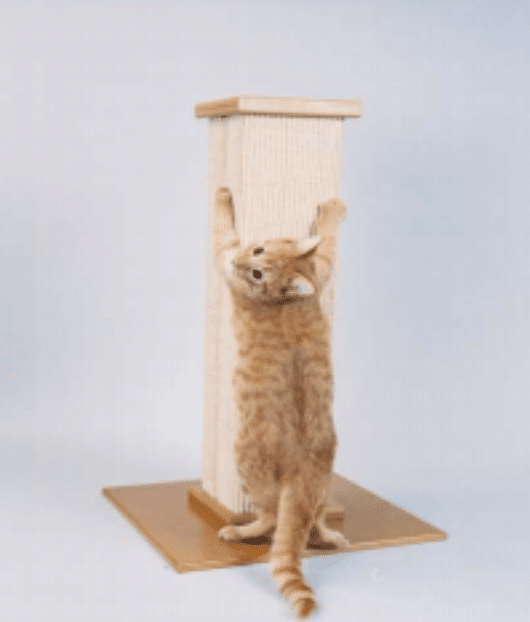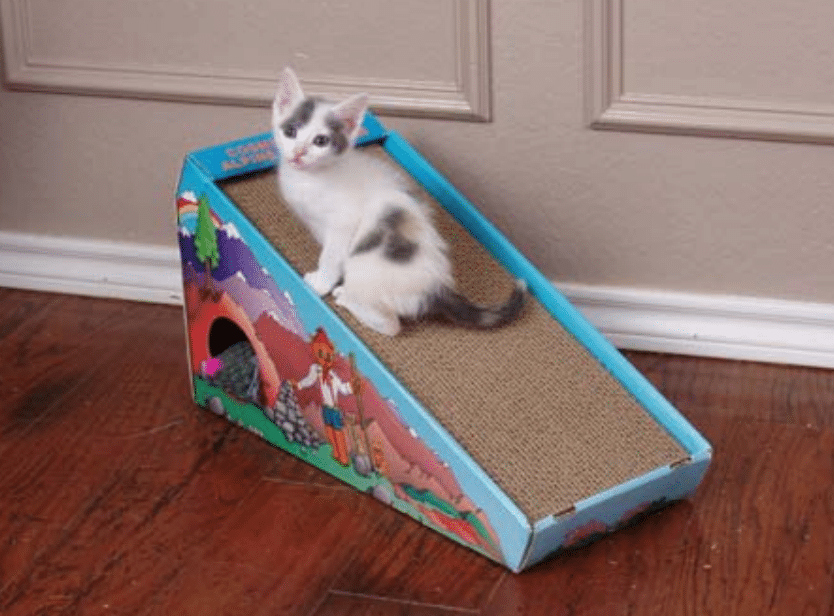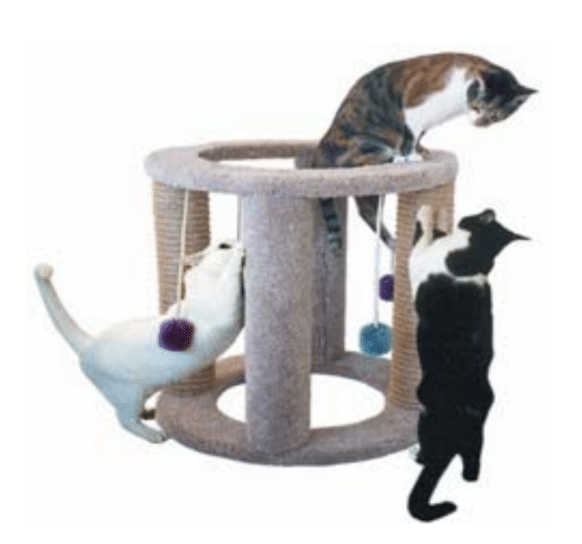
The Itch to Scratch
Cats do write. They don’t communicate with a pen and paper or by using a computer keyboard. Instead, their prose is cat scratch—literally. They scratch to express their excitement and pleasure. They scratch to leave messages, both visual and aromatic. (A cat’s paws have scent glands that leave smell-o-grams; we can’t read them, but other cats can.)
Cats also scratch, not to sharpen their nails but to remove the worn-out sheaths from their claws. You see the results as little crescent-moon shaped bits around scratching areas. Scratching is good exercise, too.
Scratching is normal behavior for cats. Asking a cat never to scratch is asking a cat not to act like a cat.
Most of us don’t mind that cats scratch; what bothers us is where they scratch. But nearly all cats can be taught where to scratch—and where not to. Kittens are particularly easy to train, but it’s not that difficult to teach the adults, either. The secret is to provide attractive scratching alternatives to the sofa or stereo speakers and then teach the cat to use those alternatives.
Reality Check
Just so you know, a typical declaw (called an onychectomy) is an irreversible surgical procedure.
A cat’s toe has three bones; the claw grows from the end of the last bone. In declawing, the veterinarian amputates the end section of the last bone, which contains the growth plate, along with the nail. This can be very painful, so pain management is critical before, during and after the procedure.
Some human amputees feel phantom pain long after a limb is gone, and declawed cats also may.
Declawing should never be performed on a cat who goes outdoors, since declawed cats have been disarmed.
In many countries declaw surgery is illegal. The American Association of Feline Practitioners advises veterinarians never to include declawing along with spay/neuter as a promotional incentive or to present declawing as a routine surgical procedure.
Even if many cats ultimately do recover without any adverse effects, why take the chance? Why put your cat through the ordeal and yourself through the expense when there are other options?
Scratching is good exercise, and it’s fun.
How Cats Scratch
Just as we have our own preferences for either pen and paper or a computer key board to write our prose, cats, too, have preferences. While almost all cats relish a vertical scratch, many also enjoy a good horizontal scratch. However, all cats seem to agree about certain requirements for their scratching surfaces.
Because cats like to stretch and scratch, favorite vertical scratchers should be equal to or exceed the cat’s height when she is standing on her back legs.
A wobbly vertical scratcher that moves and feels as if it might tip over when a cat sinks her claws in, or a horizontal scratcher that easily slides along the
floor, is not stable enough for serious scratching.
Cats like materials they can really sink their claws into. Sisal is particularly popular. Natural wood and carpeting (many cats prefer the back side of the
carpet) are also favorites. Again, it’s all about individual preferences.
An assortment of surfaces and scratchers is ideal, even in a home with just one cat. And several scratching choices are absolutely necessary in a multi-cat
household.

Scratchers 101
Effective horizontal scratchers are relatively inexpensive to buy from a pet supply store. They are often made of corrugated cardboard and sometimes catnip is included to sprinkle into slits cut in the scratcher. Angled cardboard scratchers are especially appealing to many cats, giving them a combination vertical and horizontal scratch in one.
Good vertical scratchers are tall and sturdy, with a wide, heavy bottom to prevent tipping. Industrious souls can build their own cat trees with materials
that are easy to get at home improvement stores.
While purchasing a luxurious multi-level cat tree or condo playground is pricey, it’s likely to be less expensive than a buying a new sofa because the old one has been shredded. The multiple surfaces and perches will attract feline scratchers of all preferences. And when the cats lounge on the cat tree, there will be less cat hair all over your house.
Location, Location
When you’re thinking about where to put the scratching post, keep in mind that, like all real estate, location is everything. Remember that cats scratch to communicate, and leaving a message hidden in the basement or behind the washing machine is not their idea of effective communication.
You’ll need to place the scratching post in places cats want to scratch. These include:
- Near where your family congregates.
- Near a favorite napping location, since cats enjoy a good stretch and scratch after awakening.
- Reasonably close to the front door, since many cats like to scratch after their people arrive home. (Never think your cat runs to the sofa to scratch after you walk through the door because he’s angry that you’ve been away. In fact, your cat is scratching to express his excitement to see you. Reprimanding a cat for being happy to see you is confusing and can damage your relationship with your cat.)
- As a part of a feline aerobic center, such as a sprawling cat tree, which may also include places to climb, play and snooze.
- Near a window or places where several cats gather to play and party.
Scratching School
Kittens are especially easy to instruct about where to scratch, but most any cat will learn. Realistically, it will take more time to teach an adult who has been scratching the sofa her entire life than it will to teach a 12-week-old kitty. However, mostly it depends on the individual cat and how good an instructor you happen to be. Just remember to be fair and consistent.
If you’re training an impressionable kitten, begin the first day you bring your baby home. It’s easier to start a good habit than undo a bad one. Cats learn by watching, so all you have to do is scratch your nails on the appropriate scratching post and act like you’re having a really good time. If your kitten follows your example, offer a pay-off with a tasty morsel and enthusiastically tell your cat how smart she is. Cats have huge egos; they love it when you tell them they’re the greatest.
Rubbing catnip on a vertical post and depositing catnip within the corrugated compartment of a horizontal scratcher will entice many adults to scratch. (Young kittens might not be turned on by catnip. Sometimes it’s an acquired taste and a small percentage of cats seem to never develop an interest in catnip.)
Play with your cat around the post using an interactive toy (a fishing pole type toy with feathers or fabric at the end). Even if the cat just accidentally puts her paws on the post, that’s a great start, since now your cat’s scent has been deposited on it. Consistently make the area near the scratching post a playground.
Click and Train
One way to teach your cat where to scratch is by using a clicker to tell him when he is doing the right thing. Clickers are inexpensive and easy to find at pet supply stores.
First teach your cat what the clicker means. Click the clicker and drop a treat on the floor. (For noise-sensitive cats, clicking a retractable pen will do.) Soon your cat will come running from another room when you click because he knows the click means food. Once your cat understands that “click” means “a treat is on the way,” you can use the sound of the clicker to train him to do just about anything.
Now entice your cat to paw at the post. This might be as simple as you pointing at the post and kitty following your finger. Also, play with him around the scratching post using an interactive toy. The moment your cat touches the post with any part of his body, click and offer a treat.
Learning sessions should never be more five to ten minutes, and even less time with a kitten. While kittens may actually learn faster than adults, they’re at an age when they have very short attention spans. It’s important to end a learning session with a treat for a successful behavior.
Begin the next session where you left off—with the kitty merely touching the scratcher. Your next goal is to shape the behavior to what you really want; don’t
reward the cat until he touches the scratcher with his paw.
In each successive session, hold out for a behavior that’s just a little bit closer to what you want before you click and treat. Soon your cat will be scratching
at the tree. In addition to the reward it will feel good, so your cat will enjoy the experience. Once your cat begins to scratch regularly, offer rewards only intermittently or else you’ll end up with one very pudgy pussy.

Bad Kitty
What if your cat is scratching up a favorite chair or sofa? Don’t take it personally! Remember, scratching these things is only inappropriate to you; it’s normal to your cat. You’ll need to block her access to the inappropriate place, make sure she has a fabulous scratching post to use instead, and then show her what you want her to do.
Discouraging your cat from scratching is most effective when you are not a part of the deterrent. That’s because if the reprimand comes from you, your cat quickly figures out she can scratch anywhere when you’re not around.
Remember what cats like to scratch and what they don’t. They want to dig their claws into a suitable material and they don’t like to feel something bumpy or smooth or sticky. That’s why Sticky Paws (available at pet supply stores and on line) is a superbly effective deterrent. These are strips of double-sided sticky
tape (designed not to damage furniture) that you can put on fabric or wood. Another option is ordinary double-sided tape.
If you need to cover an entire sofa or chair, try a smooth plastic tarp or shower curtain, car floor mats (with the nubby side up) or a plastic rug runner (also nubby side up).
When you discourage the cat by simply blocking her access, there is no reason to chase after and/or raise your voice or use a squirt gun. Sometimes these emotional responses will actually encourage cats to scratch, since they so love doing anything to see their people get excited.
Do you need to leave the tarp on your couch forever? Nope. The idea is to make the inappropriate items unattractive to kitty and then provide something very attractive to scratch as an alternative. So if your cat is scratching the arm of the sofa, cover it up and place an enticing scratching post right next to the sofa. It’s a set-up that tells your cat “Don’t scratch there, scratch here instead.” When your cat is consistently scratching at the right place for several weeks, you can safely uncover the sofa.

Paws ‘n Order
Keep your cat’s nails trimmed by clipping them with a nail cutter every 10 to 14 days. Your veterinarian or a groomer can show you how to do this while offering your cat a special treat as you clip. That way, your cat is so busy eating that he won’t notice you’re also clipping. Kittens can easily learn to associate a special treat with the nail clipper, so they actually look forward to the experience. (Well, at least they won’t fuss about it.)
If you and your cat just can’t see eye to eye about nail trimming, Soft Paws are soft, temporary nail covers that can be fitted over a cat’s claws.
Help Is Here!
If you still need help, it’s available. Ask your veterinarian to help you find a veterinary behaviorist. Or, to find a certified feline behavior consultant where you live, check out www.iaabc.org.
Resources
—Learn about clicker training at www.clickertraining.com or check out Clicker Training for Cats by Karen Pryor, (800) 47-CLICK
—Read Think Like a Cat by Pam Johnson Bennett (Penguin Publishing), Every Cat’s Survival Guide to Living with a Neurotic Owner by Beth Adelman (Main Street Books), Kittens for Dummies by Dusty Rainbolt (Wiley Publishing), or Bring Me Home: Cats Make Great Pets by Margaret H. Bonham (Howell Book House)
- Angelical Cat Company cat trees: www.angelicalcat.com, (954) 747-3629
- Smart Cat Ultimate Scratching Post: www.esmartcat.com/shopping/ultimate.php
- TopCat Products: www.topcatproducts.com, (615) 874-1221
- Soft Paws: www.softpaws.com, (800) 989-2542
- Sticky Paws: www.stickypaws.com, (817) 926-3023
- Steve Dale’s website: www.petworldradio.net
Author—Steve Dale, Tribune Media Services syndicated newspaper columnist, host Pet Central WGN Radio; syndicated Steve Dale’s Pet World and The Pet Minute with Steve Dale
(www.petworldradio.net)
Co-Author, Editor—Beth Adelman, certified feline behavior consultant, author and editor of more than 100 pet books
Photos—Weems S. Hutto and Dusty Rainbolt; Steve Dale, Angelical Cat Company
Ilona Rodan, DVM, ABVP, co-chair 2005AAFP Feline Behavior Guidelines Think Twice Before You Declaw
Copyright ©2005 Steve Dale, Beth Adelman. Photos copyright ©2005 Angelical Cat Company, Steve Dale, Weems S. Hutto and Dusty Rainbolt. All rights reserved.
